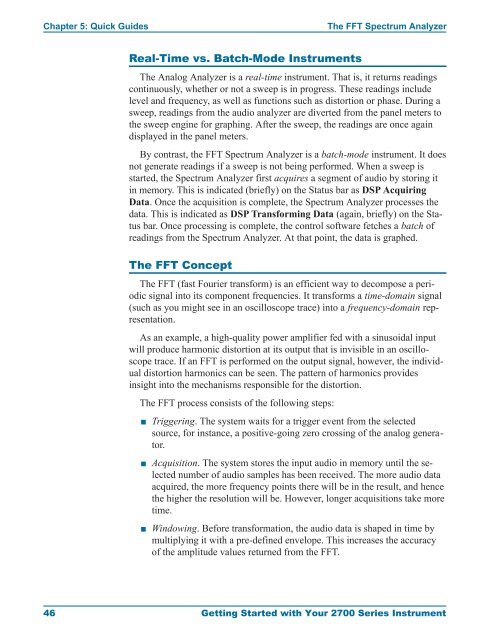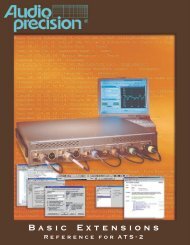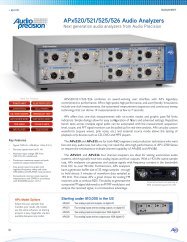Getting Started with Your 2700 Series Instrument
Getting Started with Your 2700 Series Instrument
Getting Started with Your 2700 Series Instrument
You also want an ePaper? Increase the reach of your titles
YUMPU automatically turns print PDFs into web optimized ePapers that Google loves.
Chapter 5: Quick Guides The FFT Spectrum Analyzer<br />
Real-Time vs. Batch-Mode <strong>Instrument</strong>s<br />
The Analog Analyzer is a real-time instrument. That is, it returns readings<br />
continuously, whether or not a sweep is in progress. These readings include<br />
level and frequency, as well as functions such as distortion or phase. During a<br />
sweep, readings from the audio analyzer are diverted from the panel meters to<br />
the sweep engine for graphing. After the sweep, the readings are once again<br />
displayed in the panel meters.<br />
By contrast, the FFT Spectrum Analyzer is a batch-mode instrument. It does<br />
not generate readings if a sweep is not being performed. When a sweep is<br />
started, the Spectrum Analyzer first acquires a segment of audio by storing it<br />
in memory. This is indicated (briefly) on the Status bar as DSP Acquiring<br />
Data. Once the acquisition is complete, the Spectrum Analyzer processes the<br />
data. This is indicated as DSP Transforming Data (again, briefly) on the Status<br />
bar. Once processing is complete, the control software fetches a batch of<br />
readings from the Spectrum Analyzer. At that point, the data is graphed.<br />
The FFT Concept<br />
The FFT (fast Fourier transform) is an efficient way to decompose a periodic<br />
signal into its component frequencies. It transforms a time-domain signal<br />
(such as you might see in an oscilloscope trace) into a frequency-domain representation.<br />
As an example, a high-quality power amplifier fed <strong>with</strong> a sinusoidal input<br />
will produce harmonic distortion at its output that is invisible in an oscilloscope<br />
trace. If an FFT is performed on the output signal, however, the individual<br />
distortion harmonics can be seen. The pattern of harmonics provides<br />
insight into the mechanisms responsible for the distortion.<br />
The FFT process consists of the following steps:<br />
<br />
<br />
<br />
Triggering. The system waits for a trigger event from the selected<br />
source, for instance, a positive-going zero crossing of the analog generator.<br />
Acquisition. The system stores the input audio in memory until the selected<br />
number of audio samples has been received. The more audio data<br />
acquired, the more frequency points there will be in the result, and hence<br />
the higher the resolution will be. However, longer acquisitions take more<br />
time.<br />
Windowing. Before transformation, the audio data is shaped in time by<br />
multiplying it <strong>with</strong> a pre-defined envelope. This increases the accuracy<br />
of the amplitude values returned from the FFT.<br />
46 <strong>Getting</strong> <strong>Started</strong> <strong>with</strong> <strong>Your</strong> <strong>2700</strong> <strong>Series</strong> <strong>Instrument</strong>




